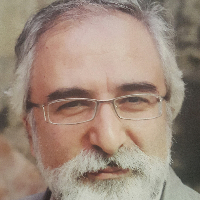Man Interpretation of Artworks (From the perspective of Gadamer's Philosophical Hermeneutics)
Author(s):
Article Type:
Research/Original Article (دارای رتبه معتبر)
Abstract:
When a person is confronted with an artwork, he speaks to it, reads it to himself, and achieves a degree of understanding and interpreting of it. Different thinkers and philosophers have offered different theories about this understanding and interpreting and what it is, and how to achieve it. The scope of these theories can be considered as a subset of two ways of thinking, namely structuralism and hermeneutics in philosophy and humanities. Structuralism seeks to methodize the understanding and interpreting of social and cultural phenomena and resorts to linguistics and semiotics through structures and patterns. Structuralisms speak with confidence and certainty about scientific methods that will lead to achieving the final, ultimate, absolute, definitive, comprehensive and complete interpreting of everything, including the art works. Hermeneutics is also known as the science of understanding, human works, and interpretation of texts. Hermeneutics also deals with the study of interpreting, human works, and the interpretation of texts. If we consider two different forms for hermeneutics, the first form is traditional hermeneutics, which follows the theories of biblical interpretation. It was founded on the ideas of thinkers such as Schleiermacher and Dilthey. The second form is contemporary or philosophical hermeneutics, which deals with the theories of Martin Heidegger and Hans-Georg Gadamer. Gadamer's philosophical hermeneutics deals with the study and philosophical exploration of interpreting and the necessary conditions for it. Therefore, there are different perspectives that discuss how to interpret the artworks. This study discusses how man interpret the artworks from the perspective of the contemporary hermeneutics of Hans-Georg Gadamer. Therefore, this research seeks to answer the question of how man achieves an interpretation of artworks. The aim of the current research is to understand how to interpret art works from Gadamer's point of view. The current research is "fundamental-theoretical" in terms of purpose and is presented as "interpretive-analytical" in terms of nature and method, and "library" is term of data collection method, and in terms of analysis method is "qualitative". After studying the methods that are used in qualitative research for data analysis, the phenomenological method was chosen with the approach of interpretive phenomenology or hermeneutic phenomenology, which was the most relevant for the nature of the research. This method is one of the most famous contemporary philosophies, which claims to interpret concepts in order to penetrate them. Therefore, in this research, we will also doubt all the past existing interpreting of art works and once again we will examine everything by the phenomenological method and from the perspective of Gadamer's philosophical hermeneutics. Therefore, it first examines the concepts of "artwork", "man", and "interpretation" and its relation to understanding and Hermeneutics, and then examines how man interpret the art works from Gadamer's perspective. In concept of "artwork", the research explained what art is, its relationship with techne, technology and aesthetics, and pointed out the reduction of the study of art to aesthetics in the Renaissance era and after. Also, the discussion about "man" and his position and dignity started from the Renaissance era and a fundamental change in the worldview of man. Man turned from heaven to earth. In other words, the human intellectual world gradually broke away from the values and thoughts with a supernatural orientation and turned to the thoughts and values related to the natural world and human life. As a result of Cartesian thinking, man was placed in the center and reached a new interpreting of concepts such as art and art works. Art was reduced to having a pleasant and artistic pleasure. And paying attention to instrumental and calculating reason, natural sciences, and scientific methods leads man to dominate nature, But Heidegger and Gadamer deny the thinking of their contemporaries. In concepts of "interpretation" and its relation to understanding and Hermeneutics, the existing translations of hermeneutics in Persian language were referred to and finally the differences of opinion regarding the translation of this word were ignored and the meaning of "to interpret" was considered for this word.
With these prerequisites, the research focused on the interpreting of art works from Gadamer's point of view. Gadamer's view on how to interpret an artwork summarized in seven key points:First point: man interpreting of an artwork is not an immutable, final, comprehensive, and complete interpreting; because man is always navigating this path and every time new ways appear in this path. Man, as an interpreter of artwork, will receive a manifestation of the truth of artwork at any point in time. Therefore, reaching certainty and a definitive answer has no place in interpreting the artwork in philosophical hermeneutics. From Gadamer's point of view, there cannot be a superior interpreting of artwork, and interpreting the artwork is an endless process and cannot be predicted.
Second point: interpreting the artwork is in many ways related to the concept of the game. These include going beyond the usual experience, understanding their rules and surrendering to it, having an uncertain end, and not being instrumental.
Third point: The artwork does not always have the same meaning, there are always different and multiple interpretations of an artwork, and different interpreters may provide different interpretations of the artwork. These interpretations will be different depending on the time horizon, historical perception of the interpreter and the relationship and interaction between the artwork and its interpreter. The endless number of interpretations of an artwork is possible and natural.
Fourth point: The mental background and previous knowledge of the interpreter of the artwork has a significant impact on his interpreting of the art work. The combination of beliefs, traditions, and perceptions that man inherits from his ancestral culture, society, and religion makes his interpreting.
These factors create a mentality for the interpreter of artwork in order to start a conversation with the artwork. When the interpreter encounters an artwork, his understanding and orientation towards that artwork is influenced by the totality of cultures and traditions that encompass his life and to which the interpreter belongs.
Fifth point: interpreting of artwork also occurs when a person penetrates into the language. In other words, interacting with the artwork leads to its interpretation. The interpreter of art work must first understand the language of art work, and a dialogue takes place between the interpreter and the art work. As a result, a common language is obtained. And interpreting comes from this common language.
Sixth point: interpreting of artwork is achieved through the hermeneutic cycle and questions and answers between the artwork and its audience.Seventh point: The time lag between the art work and the interpreter challenges the interpretation of it. Paying attention to the history of the artwork causes the emergence of a common language between the interpreter and the artwork and better interpreting.
In short, in the hermeneutic interpreting of the artwork, Gadamer proposes the absence of an unchangeable, comprehensive, complete, and final interpreting of the artwork. He proposes the entry of man into the artistic game. He points to the existence of different and multiple interpretations of artwork. He considers the mental background and prior knowledge of the interpreter to be an important point in interpreting the artwork. He finds the artwork in dialogue and conversation with man. He also considers the interpreting of artwork to be dependent on the understanding of the language of artwork. He interprets reaching a common language as a hermeneutic round. And finally, he introduces attention to time and history in interpreting artwork.
With these prerequisites, the research focused on the interpreting of art works from Gadamer's point of view. Gadamer's view on how to interpret an artwork summarized in seven key points:First point: man interpreting of an artwork is not an immutable, final, comprehensive, and complete interpreting; because man is always navigating this path and every time new ways appear in this path. Man, as an interpreter of artwork, will receive a manifestation of the truth of artwork at any point in time. Therefore, reaching certainty and a definitive answer has no place in interpreting the artwork in philosophical hermeneutics. From Gadamer's point of view, there cannot be a superior interpreting of artwork, and interpreting the artwork is an endless process and cannot be predicted.
Second point: interpreting the artwork is in many ways related to the concept of the game. These include going beyond the usual experience, understanding their rules and surrendering to it, having an uncertain end, and not being instrumental.
Third point: The artwork does not always have the same meaning, there are always different and multiple interpretations of an artwork, and different interpreters may provide different interpretations of the artwork. These interpretations will be different depending on the time horizon, historical perception of the interpreter and the relationship and interaction between the artwork and its interpreter. The endless number of interpretations of an artwork is possible and natural.
Fourth point: The mental background and previous knowledge of the interpreter of the artwork has a significant impact on his interpreting of the art work. The combination of beliefs, traditions, and perceptions that man inherits from his ancestral culture, society, and religion makes his interpreting.
These factors create a mentality for the interpreter of artwork in order to start a conversation with the artwork. When the interpreter encounters an artwork, his understanding and orientation towards that artwork is influenced by the totality of cultures and traditions that encompass his life and to which the interpreter belongs.
Fifth point: interpreting of artwork also occurs when a person penetrates into the language. In other words, interacting with the artwork leads to its interpretation. The interpreter of art work must first understand the language of art work, and a dialogue takes place between the interpreter and the art work. As a result, a common language is obtained. And interpreting comes from this common language.
Sixth point: interpreting of artwork is achieved through the hermeneutic cycle and questions and answers between the artwork and its audience.Seventh point: The time lag between the art work and the interpreter challenges the interpretation of it. Paying attention to the history of the artwork causes the emergence of a common language between the interpreter and the artwork and better interpreting.
In short, in the hermeneutic interpreting of the artwork, Gadamer proposes the absence of an unchangeable, comprehensive, complete, and final interpreting of the artwork. He proposes the entry of man into the artistic game. He points to the existence of different and multiple interpretations of artwork. He considers the mental background and prior knowledge of the interpreter to be an important point in interpreting the artwork. He finds the artwork in dialogue and conversation with man. He also considers the interpreting of artwork to be dependent on the understanding of the language of artwork. He interprets reaching a common language as a hermeneutic round. And finally, he introduces attention to time and history in interpreting artwork.
Keywords:
Interpretation , Artwork , man , Hermeneutics , Gadamer
Language:
Persian
Published:
Journal of Theoretical principles of Visual Arts, Volume:8 Issue: 2, 2024
Pages:
54 to 67
magiran.com/p2671867
دانلود و مطالعه متن این مقاله با یکی از روشهای زیر امکان پذیر است:
اشتراک شخصی
با عضویت و پرداخت آنلاین حق اشتراک یکساله به مبلغ 1,390,000ريال میتوانید 70 عنوان مطلب دانلود کنید!
اشتراک سازمانی
به کتابخانه دانشگاه یا محل کار خود پیشنهاد کنید تا اشتراک سازمانی این پایگاه را برای دسترسی نامحدود همه کاربران به متن مطالب تهیه نمایند!
توجه!
- حق عضویت دریافتی صرف حمایت از نشریات عضو و نگهداری، تکمیل و توسعه مگیران میشود.
- پرداخت حق اشتراک و دانلود مقالات اجازه بازنشر آن در سایر رسانههای چاپی و دیجیتال را به کاربر نمیدهد.
In order to view content subscription is required
Personal subscription
Subscribe magiran.com for 70 € euros via PayPal and download 70 articles during a year.
Organization subscription
Please contact us to subscribe your university or library for unlimited access!




